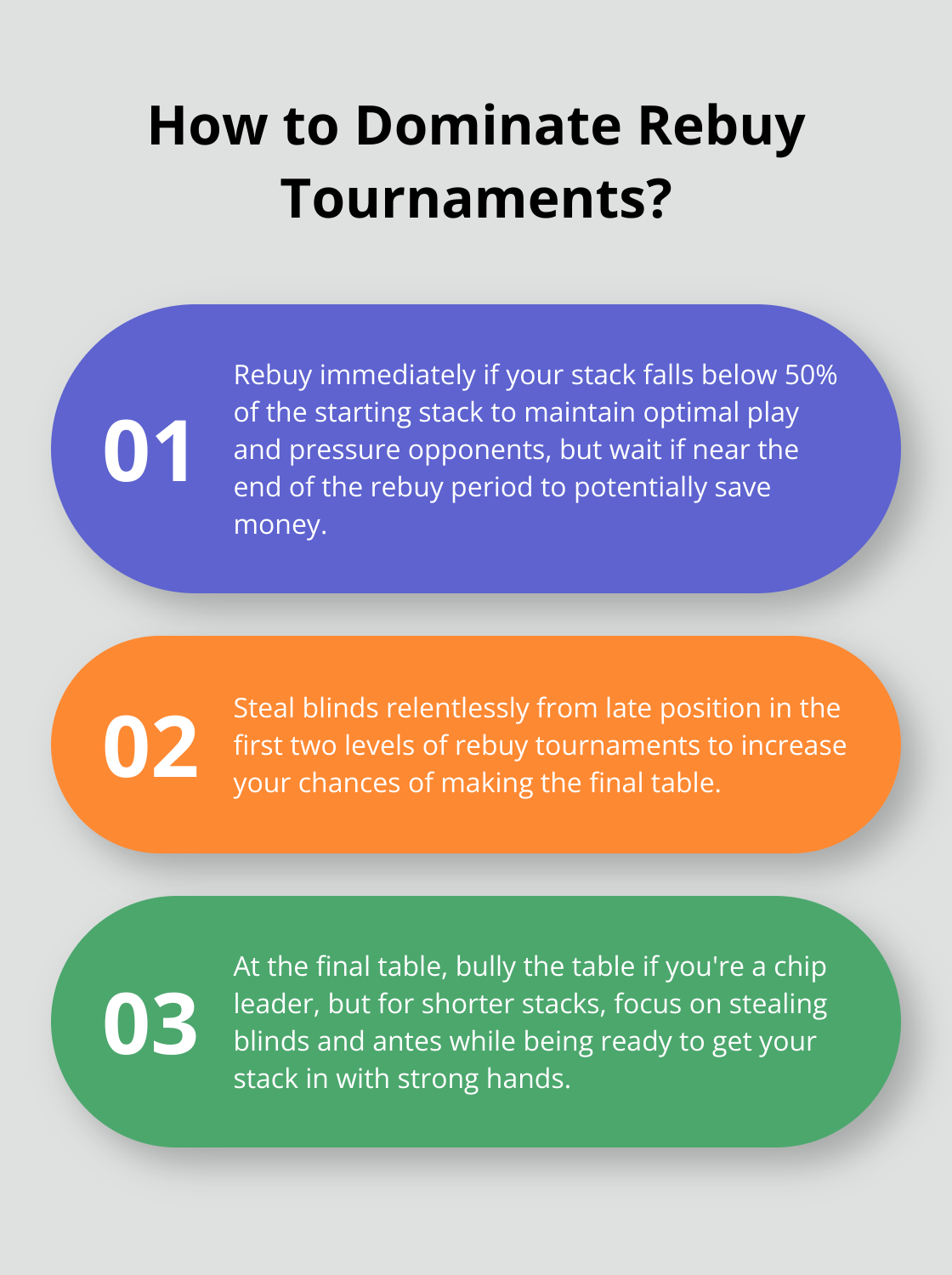Rebuy Poker Tournaments: Strategies for Success
Rebuy poker tournaments offer a unique challenge for players, combining strategic depth with the opportunity for multiple attempts. At Piter, we’ve seen these events grow in popularity due to their dynamic nature and potential for big payouts.
In this post, we’ll explore effective rebuy poker tournament strategies to help you navigate these exciting events. From early-stage aggression to late-game adjustments, we’ll cover key tactics for success at every stage of play.
What Are Rebuy Poker Tournaments?
The Mechanics of Rebuy Tournaments
Rebuy poker tournaments allow players to purchase additional chips when their stack depletes. This variant has gained massive popularity due to its dynamic nature and potential for larger prize pools. In a rebuy tournament, players can replenish their chip stack during a designated period (usually the first few levels). This feature adds an exciting twist to the game, as it allows for more aggressive play early on. Rebuy tournaments can increase the prize pool compared to standard freezeout events.
How Rebuys Differ from Standard Tournaments
The key difference lies in the ability to re-enter after busting out. In standard tournaments, once you’re out, you’re out. Rebuys give you another shot. This changes the dynamics significantly. Players tend to take more risks early, knowing they have a safety net.
Types of Rebuy Structures
- Unlimited rebuy tournaments allow players to buy back in as many times as they want during the rebuy period. This can lead to massive chip stacks and wild swings in the early game.
- Add-ons are a one-time opportunity to purchase additional chips, usually at the end of the rebuy period.
- Freezeout periods typically follow the rebuy phase, where no more rebuys are allowed.
Each structure requires a different strategy. In unlimited rebuys, it’s often beneficial to play aggressively early. With add-ons, timing is crucial. Freezeout periods demand a shift to more conservative play.
The Impact on Bankroll Management
Rebuy tournaments can be deceptive when it comes to bankroll management. While the initial buy-in might seem affordable, multiple rebuys can quickly add up. It’s important to set a limit on how many rebuys you’re willing to make before the tournament starts. A good rule of thumb is to prepare for at least three buy-ins: your initial entry, one rebuy, and the add-on.
Choosing the Right Platform
When selecting a platform for rebuy tournaments, consider factors such as tournament variety, rebuy structures, and prize pools. Wolfbet, for instance, offers a range of rebuy tournaments with various structures to suit different playing styles and bankrolls. Their platform provides detailed information on each tournament’s rebuy structure, helping players make informed decisions before they sit down at the virtual felt.

As we move into the next section, we’ll explore strategies for the early stages of rebuy tournaments, where aggressive play can make or break your chances of success.
How to Dominate Early in Rebuy Tournaments
Aggressive Play: The Key to Early Success
The early stages of a rebuy poker tournament require an aggressive approach. At Wolfbet, successful players often adopt a bold stance from the start. This strategy allows you to build a formidable stack quickly or find yourself rebuying frequently.
Aggressive play from the start creates bigger pots, which in turn makes your stack bigger and gives you a better chance of success. This highlights the importance of early aggression.

To capitalize on this, raise with a wider range of hands than usual. Don’t hesitate to 3-bet light or even 4-bet bluff occasionally. Your goal is to pressure your opponents and accumulate chips rapidly.
The Art of Rebuying
Knowing when to rebuy is essential. If your stack falls below 50% of the starting stack, rebuy immediately. This ensures you have enough chips to play optimally and pressure your opponents.
However, if you approach the end of the rebuy period, wait. You could potentially save money by playing a short stack for a few hands until the add-on phase.
Exploiting Tight Players
Many players in rebuy tournaments play tight early on, waiting for premium hands before committing chips. This mistake creates opportunities for exploitation.
Your aggressive play can often force these tight players to fold, even with decent hands. They often hesitate to risk their stack early, giving you free reign to steal blinds and antes.
Pro tip: Focus on players who haven’t rebought yet. They tend to play even tighter, making them prime targets for your aggression.
The Power of Position
In the early stages of rebuy tournaments, position becomes even more powerful. Late position allows you to see how many players have entered the pot before you act. This information proves invaluable in a rebuy tournament where play tends to be looser.
Use your position to steal blinds relentlessly. Players who steal blinds more often in the first two levels of rebuy tournaments have a higher chance of making the final table.
Embracing Variance
The goal in the early stages is to accumulate chips or bust trying. If you find yourself constantly nursing a short stack, you’re likely playing too passively. Embrace the variance and play aggressively.
As we move into the later stages of the tournament, your strategy will need to adapt. The next section will explore how to navigate the changing dynamics after the rebuy period ends.
How to Adapt Your Strategy in Late-Stage Rebuy Tournaments
The Post-Rebuy Shift
As the rebuy period ends, the tournament dynamics change dramatically. Players with massive stacks now face the challenge of protecting their chips while continuing to accumulate. Short stacks fight for survival, looking for spots to double up.

Many players tighten up significantly after rebuys are no longer available. This creates opportunities for those who can adjust quickly. Players who maintain a slightly more aggressive style than the field often perform well in this phase.
A key strategy involves targeting players who overextended during the rebuy period. These opponents often struggle to adapt to the new dynamics and continue to play too loosely. Apply pressure with well-timed raises and 3-bets to chip away at their stacks without risking too much of your own.
Big Stack vs Short Stack Play
If you’ve built a big stack, your primary goal is to keep the pressure on your opponents. Continue to open-raise frequently, but prepare to fold to 3-bets more often than in the early stages. Your chip advantage allows you to put immense pressure on medium and short stacks, forcing them to make tough decisions for their tournament lives.
For short stacks, patience becomes key. Look for spots to shove when you have fold equity, particularly against big stacks who may overplay their advantage. The ideal shoving range for a 10-15 big blind stack includes pairs 22+, ATs+, KQs, and AJo+.
Navigating the Bubble
As the tournament approaches the money bubble, play often tightens up considerably. This is where understanding ICM (Independent Chip Model) becomes important. Big stacks should apply maximum pressure on medium stacks, who often have the most to lose by busting just short of the money.
Short stacks should gamble more liberally during this phase. The added fold equity from other players trying to sneak into the money can be a powerful weapon. Don’t hesitate to shove light if you spot a good opportunity.
Final Table Tactics
At the final table, every decision becomes magnified. Pay close attention to stack sizes and adjust your strategy accordingly. If you’re among the chip leaders, don’t fear to bully the table. However, be wary of other big stacks who might attempt the same.
For shorter stacks at the final table, picking your spots becomes essential. Look for opportunities to steal blinds and antes, but be ready to get your stack in when you pick up a strong hand.
Platform Selection
When selecting a platform for rebuy tournaments, consider factors such as tournament variety, rebuy structures, and prize pools. Wolfbet offers a range of rebuy tournaments with various structures to suit different playing styles and bankrolls. Their platform provides detailed information on each tournament’s rebuy structure, helping players make informed decisions before they sit down at the virtual felt.
Final Thoughts
Rebuy poker tournament strategy demands a flexible approach. Players must adapt their tactics as the event progresses, shifting from aggressive play in early stages to a more calculated style later on. Success hinges on understanding the changing dynamics and exploiting opponents who fail to adjust their gameplay.

Effective bankroll management plays a vital role in rebuy tournaments. Players should set clear limits on rebuys and add-ons before the event begins to avoid overspending. Mastering the transition between different play styles as the tournament structure changes will ensure competitiveness at every stage.
Wolfbet offers a variety of rebuy tournaments with different structures and prize pools. Players can test their skills and implement refined strategies on this platform. With attractive welcome bonuses and potential for significant payouts, Wolfbet provides an excellent opportunity for players to enhance their rebuy tournament performance.



